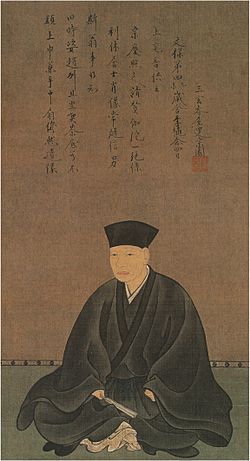Sen no Rikyu facts for kids

Sen no Rikyu (1522–1591) was a very important person in the history of the Japanese tea ceremony. He made many lasting changes to how the tea ceremony was done. He was a close helper and tea master for Toyotomi Hideyoshi, a powerful leader in Japan. Besides the tea ceremony, Rikyu also practiced ikebana (the art of flower arranging) and wrote poetry. He also studied Zen Buddhism, which influenced his ideas about tea.
Contents
Who Was Sen no Rikyu?
Sen no Rikyu was born in 1522 in Sakai, Japan. This city was a busy port and a center for trade and culture. His family was involved in the fish business. From a young age, Rikyu began to study the tea ceremony. He learned from famous tea masters of his time. He quickly became known for his skill and unique ideas.
Rikyu's Simple Tea Style
Before Rikyu, the tea ceremony could be very fancy. It often used expensive Chinese bowls and decorations. Rikyu believed in a simpler, more natural way. He liked using local Japanese pottery, even if it looked plain. He focused on the beauty of imperfection and quietness. This style is called wabi-cha. It means finding beauty in simple, rustic things.
The Wabi-cha Philosophy
Wabi-cha is about more than just making tea. It's about a way of life. It teaches you to appreciate quiet moments. It encourages you to find beauty in things that are not perfect. Rikyu's tea rooms were often small and simple. They had natural materials like wood and bamboo. This made guests feel calm and connected to nature.
Rikyu and Toyotomi Hideyoshi
Sen no Rikyu became the personal tea master for Toyotomi Hideyoshi. Hideyoshi was a powerful general who united Japan. He loved the tea ceremony and trusted Rikyu's advice. Rikyu helped Hideyoshi with many important events. He even designed tea rooms for Hideyoshi's castles. Their relationship was very close, but also complicated.
The Grand Kitano Tea Gathering
In 1587, Hideyoshi held a huge tea gathering at Kitano Shrine in Kyoto. Rikyu helped organize this event. Hideyoshi invited everyone, from nobles to common people. The idea was to share the beauty of tea with everyone. This event showed how important the tea ceremony had become in Japan. It also showed Rikyu's influence.
Rikyu's Legacy
Sen no Rikyu's ideas changed the Japanese tea ceremony forever. He taught that the tea ceremony is not just about drinking tea. It's about respect, purity, harmony, and tranquility. These are known as the "Four Principles of Tea." His teachings are still followed today.
The Four Principles of Tea
- Harmony (Wa): Everyone in the tea room should feel connected. People, nature, and the tea tools should all be in balance.
- Respect (Kei): Show respect to others, to nature, and to the tea tools.
- Purity (Sei): Keep your heart and mind pure. The tea room should be clean and simple.
- Tranquility (Jaku): Find peace and calm during the tea ceremony. This quietness helps you appreciate the moment.
Influence on Japanese Culture
Rikyu's influence went beyond the tea ceremony. His ideas about wabi-cha affected other Japanese arts. These included gardening, architecture, and pottery. He showed that simple beauty could be very powerful. Many tea schools today trace their origins back to Rikyu's teachings.
Images for kids
See also
 In Spanish: Sen no Rikyū para niños
In Spanish: Sen no Rikyū para niños




